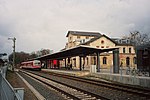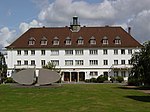Marienkirche, Wolfenbüttel
17th-century Lutheran churches in GermanyBuildings and structures in WolfenbüttelLutheran churches in Lower Saxony

The Marienkirche is a main church (Hauptkirche) in Wolfenbüttel, Lower Saxony, Germany. The official name of the Lutheran church is Hauptkirche Beatae Mariae Virginis (Main church of the Blessed Virgin Mary). Short common names are Hauptkirche BMV, or simply BMV. It is regarded as the first major Protestant church. It was commissioned by Henry Julius, Duke of Brunswick-Lüneburg. Building began in 1608, directed by Baumeister Paul Francke. The portals in the north and south are attributed to Jacob Meyerheine.
Excerpt from the Wikipedia article Marienkirche, Wolfenbüttel (License: CC BY-SA 3.0, Authors, Images).Marienkirche, Wolfenbüttel
Kornmarkt,
Geographical coordinates (GPS) Address Website External links Nearby Places Show on map
Geographical coordinates (GPS)
| Latitude | Longitude |
|---|---|
| N 52.162037 ° | E 10.53720265 ° |
Address
Hauptkirche Beatae Mariae Virginis
Kornmarkt
38300 , Heinrichstadt
Lower Saxony, Germany
Open on Google Maps







